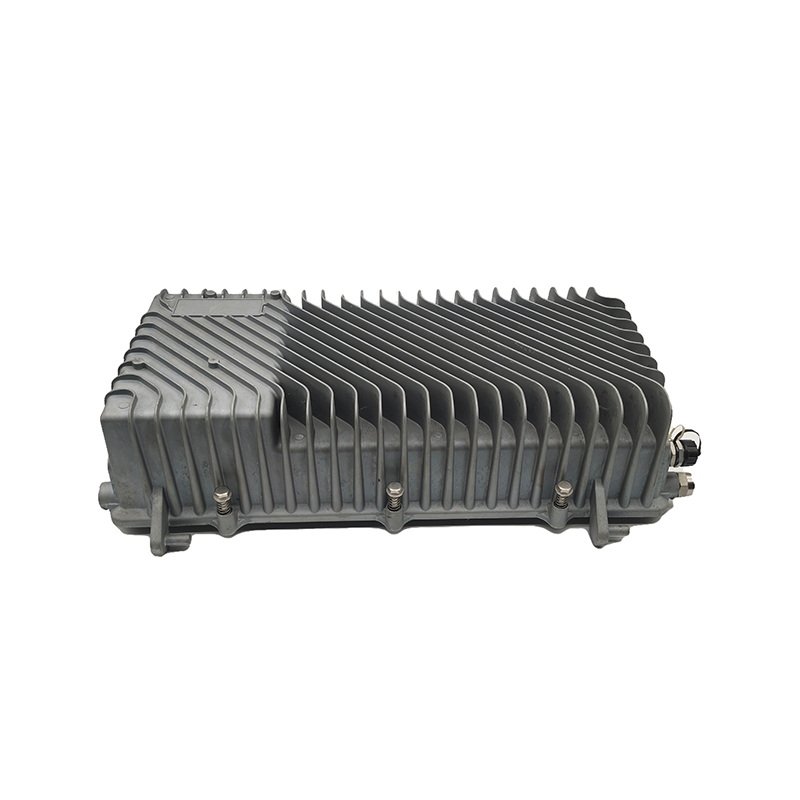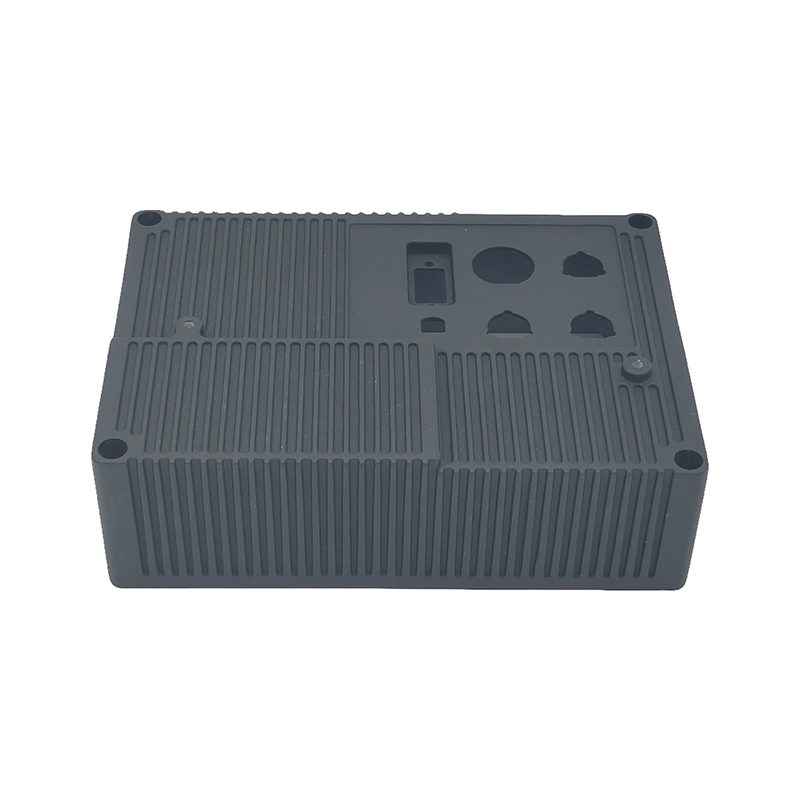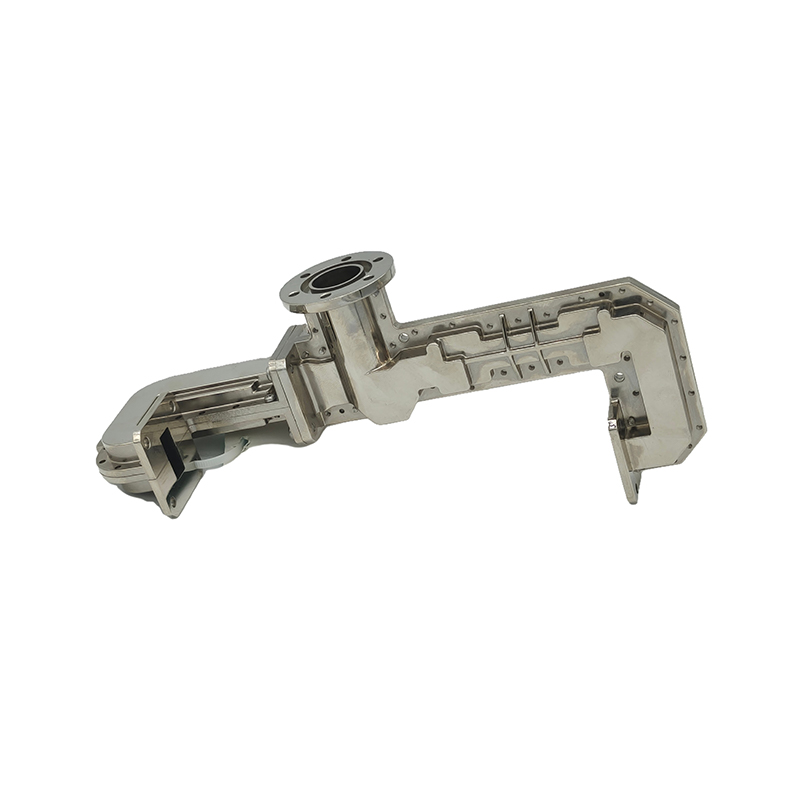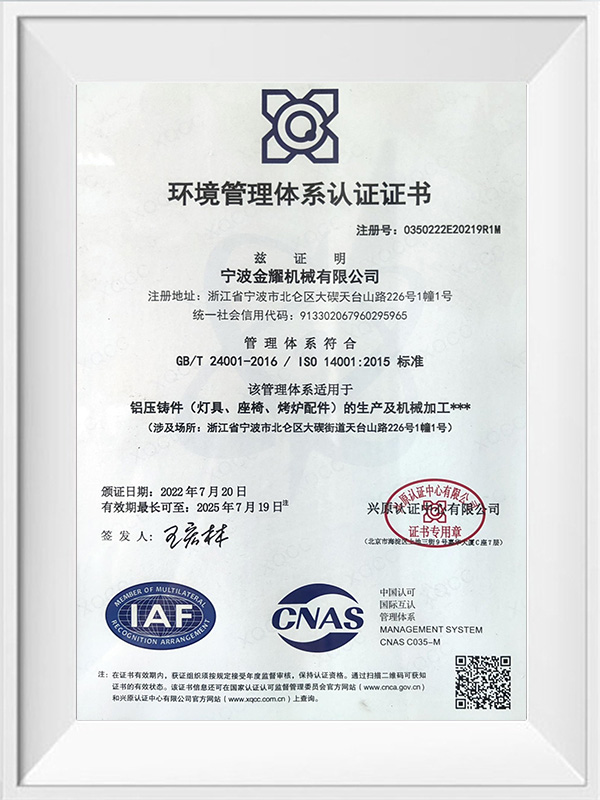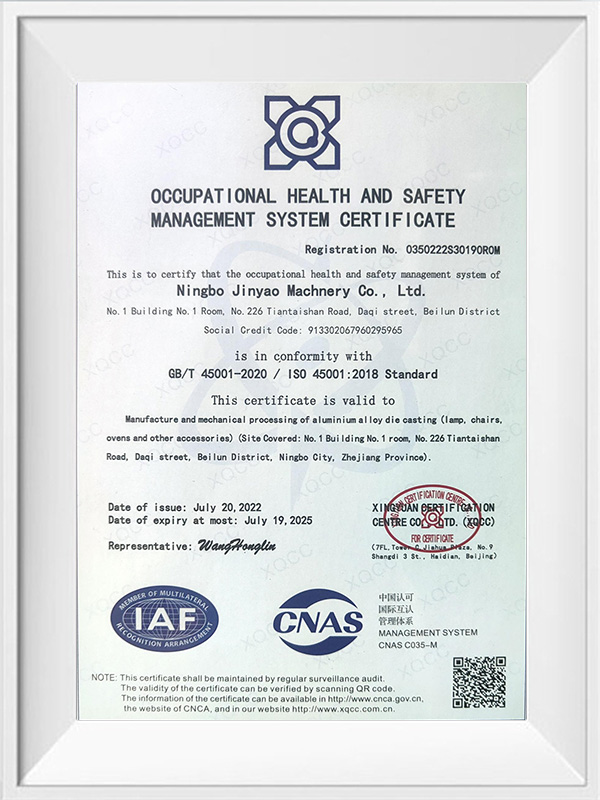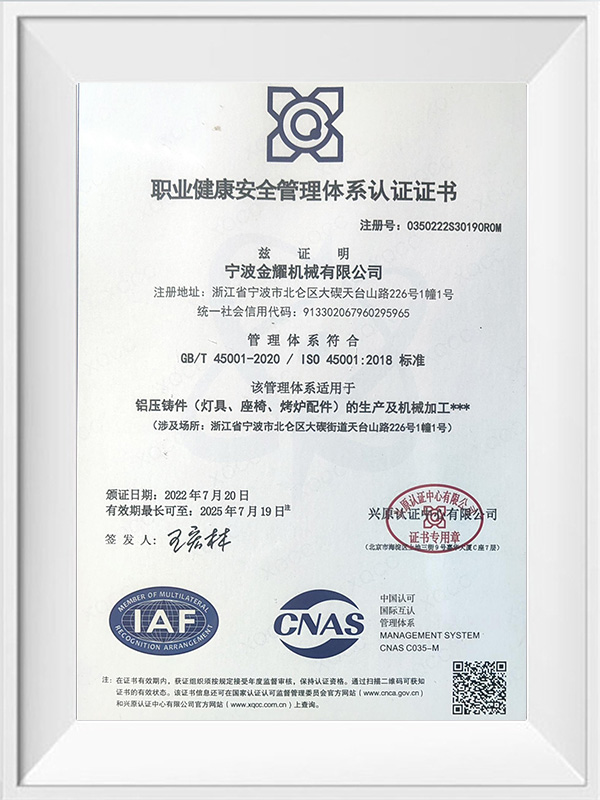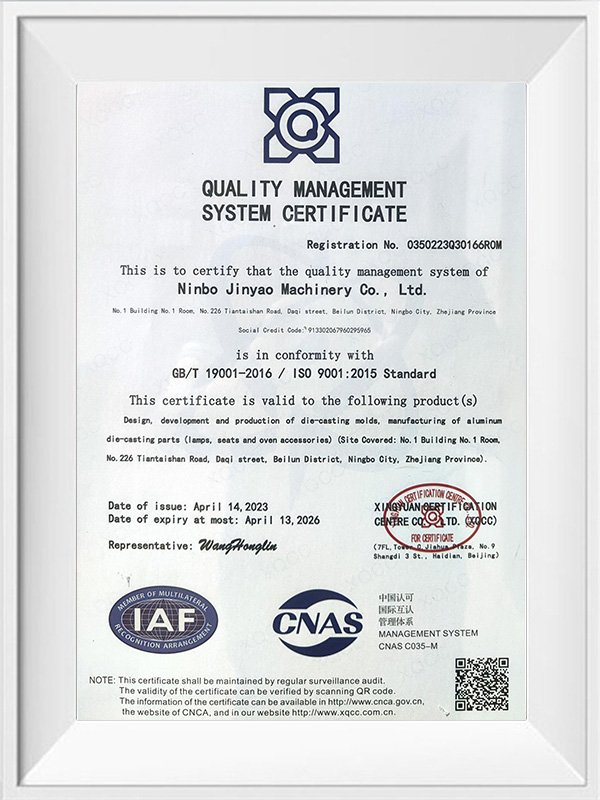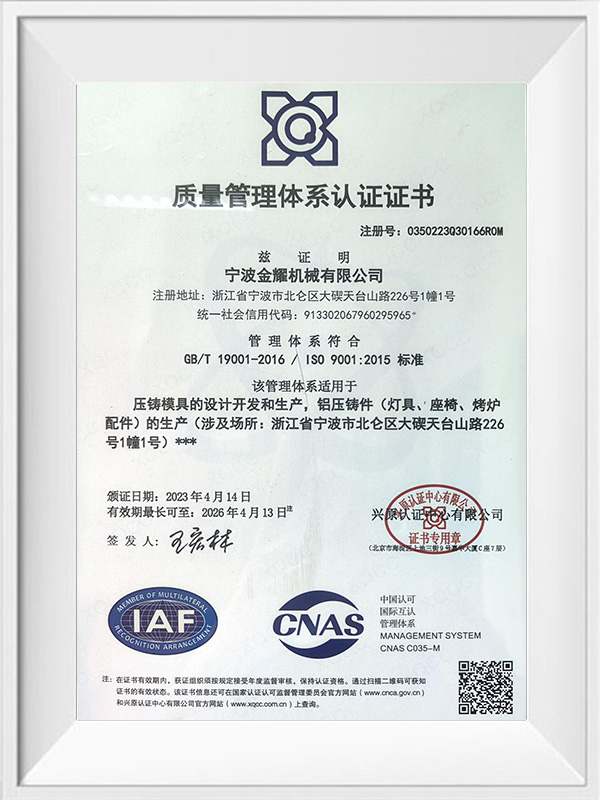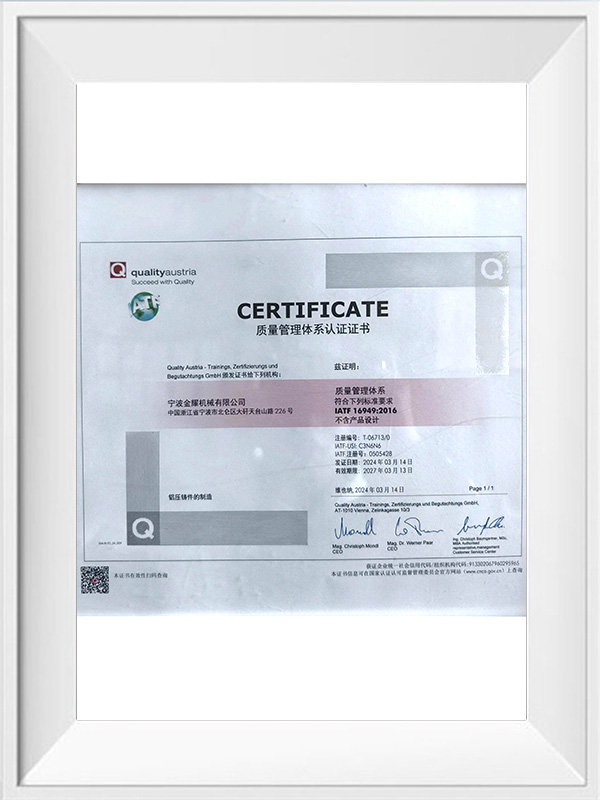Ningbo Jinyao Machinery Co., Ltd. is a China Communication Housing Die Castings Manufacturers and Die Casting Communication Housing Factory. And is an enterprise integrating industry and trade, dedicated to the production of precision castings of aluminum alloy materials and the design and manufacture of high-pressure die-casting molds. Adopting advanced vacuuming, pin extrusion, and high-pressure spot cooling processes, it is a large-scale professional production base for diversified casting in China. It integrates a precision casting factory and a mechanical processing plant, and can produce precision castings and various types of castings annually. More than 10,000 tons, mainly exported to Japan, Sweden and other countries. Among the customers we cooperate with are many OEM customers of trains, cars, forklifts, outboards, communication equipment, lamps, furniture parts and engineering machinery, including the world's top 500 companies. , has become an important supplier of their precision castings in China.
Communication Housing Die Castings Manufacturers
- Traditional automobile die castings
- New energy automobile die castings
- Communication housing die castings
- Electric scooter die castings
- Bicycle power motor die castings
- Motorcycle accessories die castings
- Motor housing die castings
- Engineering machinery die castings
- Lighting die castings
- Outboard motor die castings
- Furniture accessories die castings
- Grill accessories die casting
- Photovoltaic inverter die castings
Communication housing die castings are key enclosures and structural components used in communication equipment, typically manufactured from metal materials such as aluminum alloys through high-pressure die-casting processes. These die castings primarily serve to protect internal electronic components from external environmental factors while providing heat dissipation and electromagnetic shielding functions, ensuring the stable operation of the equipment.
Due to the high demands for precision, strength, and appearance quality in communication equipment, communication housing die castings must feature complex geometries and strict dimensional tolerances during design and manufacturing to meet the needs for miniaturization and high integration of the devices. Additionally, these die castings often undergo various surface treatment processes, such as painting, electroplating, or anodizing, to enhance their corrosion resistance and aesthetic appeal while improving their durability in various complex environments.
Communication housing die castings are widely used in base station equipment, routers, switches, antenna housings, smart terminals, and other communication devices. Through advanced die-casting processes and stringent quality control, each part is ensured to possess mechanical and electrical properties, providing reliable physical protection and performance support for communication equipment. The high strength, lightweight nature, and good thermal conductivity of these die castings make them the preferred enclosure material in the communication industry, capable of enhancing the overall stability and lifespan of the equipment while efficiently dissipating heat.
-
What Innovations Are Shaping the Future of Die Casting in Photovoltaic Inverter Design?View More
The photovoltaic (PV) inverter industry is evolving rapidly, driven by technological advancements and the increasing demand for renewable energy solutions. Die casting, a key manufacturing process for PV inverter components, is undergoing several innovations that enhance performance, reduce costs, a...

-
Why Is Aluminum Die Casting Better Than Other Metal Casting Methods?View More
1. Introduction: The Evolution of Metal Casting Metal casting has been one of the most fundamental manufacturing processes for centuries. From simple tools to complex automotive and aerospace components, casting allows molten metal to take shape in reusable molds.However, as industries have evolved,...

-
Why Should Manufacturers Choose Die Casting for Gearbox Systems Over Other Methods?View More
Die casting has become the go-to manufacturing process for producing gearbox systems, offering a combination of precision, strength, cost-efficiency, and design flexibility. In this article, we will explore in detail why manufacturers should choose die casting for gearbox systems over other methods ...

Communication housing die castings are important housings and structural components for communication equipment. They are usually made of metal materials such as aluminum alloys and processed by high-pressure casting. Their main function is to protect internal electronic components from external environmental factors, and they also have heat dissipation and electromagnetic shielding functions to ensure stable operation of the equipment.
Design requirements for communication housing die castings
The design of communication housing die castings needs to consider multiple factors, including the appearance requirements of the equipment, heat dissipation requirements, anti-electromagnetic interference capabilities, and the influence of external environmental conditions. The following are several aspects that require special attention during the design process:
Precision and complexity: Due to the extremely high precision requirements of communication equipment for the housing, the design of communication housing die castings usually involves complex geometric shapes, such as narrow gaps, small holes and other difficult structures, which need to be strictly controlled during the casting process. The high-pressure casting process can effectively maintain the high precision of the castings and meet the dimensional tolerance requirements of the equipment.
Heat dissipation performance: Communication equipment often generates a lot of heat when working, especially during high-speed transmission and data processing. To this end, the communication housing casting must have good heat dissipation performance. Metal materials such as aluminum alloys have good thermal conductivity. When designing, heat sinks, heat dissipation holes and other structures are often added to improve the heat dissipation effect and ensure the long-term stable operation of the equipment.
Anti-electromagnetic interference (EMI) capability: Electromagnetic interference is a major challenge in the operation of communication equipment, so communication housing die castings need to have good electromagnetic shielding function. Metal materials such as aluminum alloys have good electromagnetic shielding capabilities, which can effectively block the interference of external electromagnetic waves, and also prevent the electromagnetic waves generated inside the equipment from affecting other equipment.
Corrosion resistance and surface treatment: Communication housing die castings are usually used in outdoor environments or extremely complex working environments, so their corrosion resistance is crucial. In order to improve the corrosion resistance of castings, surface treatment processes such as electroplating and anodizing are often used. In addition, surface treatment can also improve the appearance and enhance the beauty of the equipment.
Structural strength and weight: While ensuring the strength of the housing, the weight of the communication housing casting also needs to be controlled. Materials such as aluminum alloys are ideal for communication housings because of their light weight and high strength. The strength of this material is sufficient to protect the internal components from external impact, and the lighter weight can also effectively reduce the overall weight of the equipment, making it easier to transport and install.
Manufacturing process of communication housing die castings
The manufacture of communication housing die castings usually adopts high-pressure casting process, which can efficiently produce precision castings of complex shapes. The specific manufacturing process is as follows:
Mold design and production: The first step of high-pressure casting is to design and manufacture the mold. The design of the mold needs to take into account factors such as the geometry, dimensional tolerance, and heat conduction of the casting. In order to ensure the long-term service life of the mold, high-temperature resistant and corrosion-resistant materials are usually used for manufacturing.
Melting and casting: Metal materials such as aluminum alloys are melted and injected into the mold. During the casting process, the molten metal is forced into every detail of the mold by applying high pressure to ensure that all parts of the casting are evenly molded.
Cooling and demolding: After the casting is cooled in the mold, the demolding process begins. The high-pressure casting process has a faster cooling rate, which helps to improve the strength and hardness of the casting.
Post-processing process: After the casting is removed from the mold, it is usually necessary to perform subsequent processes such as deburring, cleaning, and surface treatment. Common surface treatment processes include spraying, electroplating, and anodizing, which not only improve the beauty of the casting, but also increase its corrosion resistance and durability.
Precision machining and inspection: For some communication housing die castings with complex structures and precision requirements, precision machining such as drilling, milling, and cutting may also be required. In addition, castings also require strict quality inspections, including appearance inspection, dimensional measurement, strength testing, and performance evaluation.
Application areas of communication housing die castings
Communication housing die castings are widely used in various communication equipment. The following are several major application areas:
Base station equipment: Base station equipment is an important part of the communication network. Communication housing die castings are used to protect electronic components in the base station from environmental influences. Aluminum alloy housings can effectively block external factors such as dust and rain, while providing heat dissipation and electromagnetic shielding functions.
Routers and switches: Routers and switches are important equipment for realizing network data transmission. Communication housing die castings are used for their external protection to ensure that the equipment is free from interference and damage during operation. The heat dissipation performance of the housing is crucial for the stable operation of these devices.
Antenna housing: As one of the core components of communication equipment, the antenna usually needs to work for a long time in the external environment. Communication housing die castings provide a solid housing protection for the antenna to prevent it from being damaged by external factors and ensure the stability of signal transmission.
Smart terminals: With the popularization of smart terminals, the application scope of communication housing die castings has gradually expanded. These castings are usually used in smart devices such as mobile phones and tablets, which can not only provide external protection, but also meet the equipment's needs for lightness, heat dissipation and beauty.
Other communication equipment: In addition to the above applications, communication housing die castings are also widely used in other communication equipment, such as optical fiber equipment, satellite communication equipment, etc., giving full play to their advantages in high precision, high strength and high durability.
Advanced technology and production advantages adopted by Ningbo Jinyao Machinery Co., Ltd.
Ningbo Jinyao Machinery Co., Ltd. adopts advanced process technologies such as vacuum casting, pin extrusion and high pressure point cooling, which greatly improves the production efficiency and quality of communication housing die castings. Below we will explain the advantages of these technologies and their application effects in production.
Vacuum casting: Vacuum casting eliminates bubbles and impurities by casting aluminum alloy metal in a vacuum environment, thereby reducing defects and improving casting quality. This process provides a smooth and flat surface that meets the aesthetic requirements of communication housings, while improving casting accuracy, reducing secondary processing, and saving production time and costs. As bubbles and impurities are eliminated, the density of the casting is increased, the mechanical strength and durability are enhanced, and the structural stability is ensured. In addition, the vacuum environment effectively reduces material waste and improves production efficiency and consistency.
Needle extrusion process: The needle extrusion process is suitable for manufacturing castings with complex internal structures, such as heat dissipation holes and small holes, by extruding metal materials into slender needles or small channel structures. This process can effectively improve the thermal conductivity of castings and enhance heat dissipation performance, and is particularly suitable for communication equipment housings with high heat dissipation requirements. Through the fine hole structure, heat transfer can be accelerated to ensure that the equipment temperature is maintained in the ideal range and the service life is extended. At the same time, needle extrusion can also ensure high dimensional accuracy and consistency to ensure that the assembly and performance requirements of the castings are met.
High-pressure spot cooling technology: High-pressure spot cooling technology accelerates the cooling process and controls the cooling rate by spraying coolant at high pressure to specific parts of the casting, reducing stress and deformation. This technology can improve the quality of castings, avoid shrinkage, cracks and deformation, and ensure stable size and shape. At the same time, precise control of the cooling rate can shorten the cooling time and improve production efficiency, especially in mass production. In addition, it also reduces the thermal stress caused by excessive temperature difference, enhances the mechanical properties of the casting, and reduces the risk of deformation.
Ningbo Jinyao Machinery Co., Ltd. has not only significantly improved the quality of castings, but also greatly improved production efficiency by adopting advanced technologies such as vacuum casting, needle extrusion and high-pressure spot cooling. These innovative processes enable the company to produce communication housing die castings with high precision, strength and aesthetics, meeting the strict requirements of communication equipment for complex structure, heat dissipation performance and reliability. In addition, the application of these technologies also optimizes the production process, reduces the scrap rate, shortens the production cycle, and further reduces production costs. With these technological advantages, Jin Yao Machinery has successfully provided high-quality castings to the world's top 500 companies, enhanced the company's competitiveness in the market, and established its leading position in the foundry industry.

 English
English Español
Español Deutsch
Deutsch русский
русский
 Traditional automobile die castings
Traditional automobile die castings New energy automobile die castings
New energy automobile die castings Communication housing die castings
Communication housing die castings Electric scooter die castings
Electric scooter die castings Bicycle power motor die castings
Bicycle power motor die castings Motorcycle accessories die castings
Motorcycle accessories die castings Motor housing die castings
Motor housing die castings Engineering machinery die castings
Engineering machinery die castings Lighting die castings
Lighting die castings Outboard motor die castings
Outboard motor die castings Furniture accessories die castings
Furniture accessories die castings Grill accessories die casting
Grill accessories die casting Photovoltaic inverter die castings
Photovoltaic inverter die castings